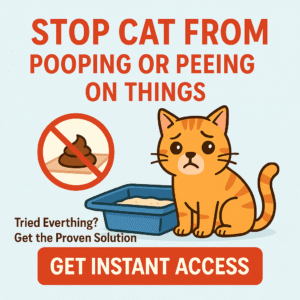Finding blood in your cat’s stool can be alarming. While the cause is sometimes minor, it’s always a sign that your cat’s digestive system needs extra care. Food plays a huge role in soothing an irritated gut, supporting healing, and preventing future flare-ups. This guide covers practical feeding strategies and gentle food options to help your cat recover—and thrive.
What Causes Blood in Cat Stool?
Blood in the stool (also called hematochezia or melena, depending on the type) can stem from a range of issues. Some common causes include:
- Sudden diet change or food intolerance
- Colitis (inflammation of the colon)
- Intestinal parasites or infections
- Food allergies or sensitivities
- Inflammatory bowel disease (IBD)
- Constipation or anal gland problems
- Serious illnesses (rare, but possible—always consult a vet if blood persists)
If blood in the stool continues for more than a day, is accompanied by vomiting, lethargy, or your cat stops eating, see your veterinarian immediately. Diagnosis is essential before making dietary changes.
Key Nutrition Strategies for Cats with Digestive Bleeding
- Feed an easily digestible diet: Foods labeled “sensitive stomach” or “gastrointestinal” use gentle ingredients and break down easily, reducing irritation.
- Limited-ingredient formulas: Fewer ingredients lower the risk of further gut upset and make it easier to identify triggers.
- Novel protein sources: Uncommon proteins like duck, rabbit, or venison can help if your cat is sensitive to common meats.
- Wet food or extra moisture: Canned foods add hydration and are softer on the GI tract, easing inflammation and promoting regular bowel movements.
- Added fiber: Soluble fiber from pumpkin, psyllium, or beet pulp can soothe the colon, firm up stool, and promote healthy bacteria.
- Probiotics: Some foods contain probiotics to balance gut flora and speed up recovery.
Best Cat Foods for Cats with Blood in Stool
1. Hill’s Prescription Diet i/d Digestive Care (Wet or Dry)
- Veterinarian-trusted for GI upsets, colitis, and recovery after digestive distress.
- Highly digestible proteins, prebiotics, and added electrolytes.
- Available in both wet and dry, but wet is preferred for acute symptoms.
2. Royal Canin Veterinary Diet Gastrointestinal (Wet & Dry)
- Designed for sensitive tummies and cats recovering from GI bleeding.
- Optimal blend of fiber and highly digestible ingredients.
- Contains prebiotics and omega-3s for gut healing.
3. Blue Buffalo Basics Limited Ingredient Diet (Wet)
- Single protein (like turkey or duck) and simple carbs.
- No dairy, eggs, wheat, soy, or artificial preservatives.
- High moisture for easy digestion and hydration.
4. Purina Pro Plan Sensitive Skin & Stomach (Wet)
- Uses oat meal, rice, and real turkey or duck for easy digestion.
- Formulated for cats with sensitive GI tracts.
- No artificial colors or flavors.
5. Instinct Limited Ingredient Diet Grain-Free (Wet)
- Only one animal protein and minimal plant ingredients.
- Moisture-rich and easy to digest for cats with GI irritation.
- No grains, eggs, or dairy—good for allergy-prone cats.
Practical Feeding Tips for Recovery
- Switch foods gradually over 7–10 days to avoid further GI upset.
- Feed small, frequent meals to reduce gut strain and allow for easier digestion.
- Never feed table scraps, dairy, or treats with unfamiliar ingredients during recovery.
- Add a teaspoon of plain canned pumpkin (not pie filling) to wet food for natural fiber support—ask your vet if this is suitable.
- Keep your cat’s water bowl clean and always full—hydration helps the gut heal.
- If your cat is on medication or prescribed supplements (like probiotics), give them exactly as directed.
When to Consider a Prescription Diet
If your cat’s bleeding is linked to IBD, colitis, or ongoing digestive disorders, your vet may recommend a long-term prescription food. These formulas use hydrolyzed proteins, novel ingredients, and tailored fiber blends to prevent flare-ups and maintain gut health. Never start a prescription diet without veterinary advice.
The Bottom Line
The best cat food for blood in stool is gentle, simple, and easy to digest. Wet foods with limited ingredients or veterinary formulas can help the gut heal, reduce irritation, and keep your cat comfortable. Always consult your vet for diagnosis, treatment, and personalized feeding advice—quick action and the right food can make all the difference.
This guide is for informational purposes only. Blood in your cat’s stool is never normal—see your veterinarian for a diagnosis and treatment plan before changing your cat’s food.
